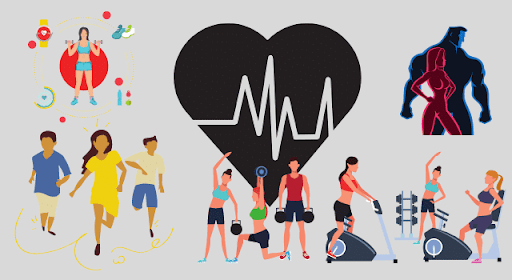
Before you start an exercise routine, ask your doctor about what exercises to do. Then make a plan to spend less time in front of the television and/or computer, and begin exercising more. Your doctor may suggest that you begin by doing little things first, such as parking in the farthest corner of your parking lot at work, taking the stairs rather than the elevator, taking your dog for a walk, or riding a stationary bike. Little by little, adding daily exercise will help you begin to feel better.
What is physical fitness?

Physical fitness refers to the body’s ability to work together efficiently to allow you to be healthy and perform activities of daily living.The ability to carry out daily tasks with vigour and alertness, without undue fatigue and with ample energy to enjoy leisure-time pursuits and to meet unforeseen emergencies.
Fitness is very important for good health. Besides feeling better mentally, exercising can help protect you from heart disease, stroke, obesity, diabetes, and high blood pressure; it can make you look younger, increase and maintain bone density, improve the quality of your life, and may keep you from getting sick. Exercising also helps you control stress better, and can make you feel happier and less nervous.
5 Components of Physical Fitness
The 5 components of physical fitness are often used in our school systems, health clubs and fitness centres to gauge how good a shape we are truly in. The 5 components that make up total fitness are:
- Cardiovascular Endurance
- Muscular Strength
- Muscular endurance
- Flexibility
- Body Composition
A closer look at the individual components:

- Cardiovascular endurance is the ability of the heart and lungs to work together to provide the needed oxygen and fuel to the body during sustained workloads. Examples would be jogging, cycling and swimming. The Cooper Run is used most often to test cardiovascular endurance.
- Muscular strength is the amount of force a muscle can produce. Examples would be the bench press, leg press or bicep curl. The push-up test is most often used to test muscular strength.
- Muscular endurance is the ability of the muscles to perform continuously without fatigue. Examples would be cycling, step machines and elliptical machines. The sit-up test is most often used to test muscular endurance.
- Flexibility is the ability of each joint to move through the available range of motion for a specific joint. Examples would be stretching individual muscles or the ability to perform certain functional movements such as the lunge. The sit and reach test is most often used to test flexibility.
- Body composition is the amount of fat mass compared to lean muscle mass, bone and organs. This can be measured using underwater weighing, Skinfold readings, and bioelectrical impedance. Underwater weighing is considered the “gold standard” for body fat measurement, however because of the size and expense of the equipment needed very few places are set up to do this kind of measurement.


